Tag: biography
H. K. Riikonen: Nukuin vasta aamuyöstä. Olavi Paavolainen 1903–1964 [I didn’t fall asleep until morning. Olavi Paavolainen 1903–1964]
9 April 2015 | Mini reviews, Reviews
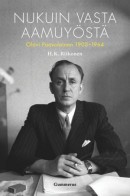 Nukuin vasta aamuyöstä. Olavi Paavolainen 1903–1964
Nukuin vasta aamuyöstä. Olavi Paavolainen 1903–1964
[I didn’t fall asleep until morning. Olavi Paavolainen 1903–1964]
Helsinki: Gummerus, 2014. 584 pp., ill.
ISBN 978-951-20-9714-2
€36.90 , hardback
In the 1920s and 1930s the author and journalist Olavi Paavolainen was a prominent cultural figure among young writers and artists. Published after the Second World War, his controversial war diary, Synkkä yksinpuhelu (‘Sombre monologue’, 1946), remains his best-known literary work. This book, by Professor of Literature H.K.Riikonen, focuses on Paavolainen’s literary activities and his oeuvre; it complements and deepens another biography of Paavolainen published in 2014, Tulisoihtu pimeään (‘A torch into the darkness’) by Panu Rajala. Riikonen thoroughly examines Paavolainen’s works as well as his post-war career as a director at the Finnish Broadcasting Company. At times Riikonen’s views, based on careful research, differ from Rajala’s interpretations. Riikonen also features the cultural life and eminent contemporary figures of Paavolainen’s era. At times the text, with its precise references and culture-historical details, meanders somewhat. The book includes plenty of quotes from Paavolainen’s works as well as interesting fact boxes related to the circumstances of his life.
Leena Liukkonen: Aatos
12 March 2015 | Mini reviews, Reviews
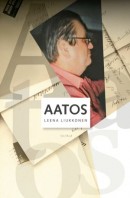 Aatos
Aatos
Helsinki: Siltala, 2014. 155 pp.
ISBN 978-952-234-225-6
€28.50, hardback
Aatos Erkko (1932–2012) was a prominent newspaper publisher and principal owner of the Sanoma group; the company’s largest and most prestigious paper is Helsingin Sanomat. Reticent by nature and possessed of a difficult personality, Erkko nonetheless tried to act in accordance with his ideals. Rarely seen in the public eye, during his lifetime he was considered one of Finland’s most influential forces behind the scenes. Even though he was not keen on taking over the reins of the paper from his father Eljas (son of the original founder) whose wish it was, Aatos Erkko took the role seriously, developing Helsingin Sanomat into the Nordic region’s largest newspaper. Journalist and writer Leena Liukkonen’s small-scale, warm-hearted portrait is based mostly on Erkko’s later years, making use of discussions and correspondence, as well as interviews recorded by a Swedish colleague. Known as Finland’s richest man, Erkko talks frankly about his difficult relationship with his parents, and the disappointments of his life. The book leaves the impression of a friendship portrayed in terms that are open and honest.
Translated by David McDuff
To write, to draw
18 December 2014 | This 'n' that
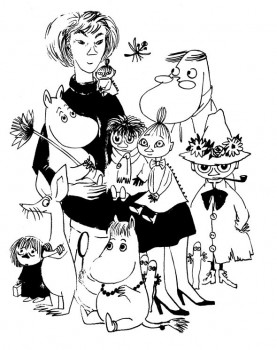
Self-portrait: Tove Jansson with her creations. Picture: @Moomin Characters™
A new Finnish biography of Tove Jansson (1914–2001) was published in 2013; the artist and creator of the Moomins has been celebrated in 2014 in her centenary year. Tove Jansson. Tee tytötä ja rakasta by Tuula Karjalainen was published in English this autumn, translated by David McDuff, under the title Tove Jansson: Work and Love (Penguin Global, Particular Books).
The book was reviewed by The Economist newspaper on 22 November. Unsurprisingly, according to the review, Jansson was more interesting as a writer than as a painter:
’Jansson always saw herself first as a serious painter. She exhibited frequently in Finland, and won awards and commissions for large public murals. Her reputation there as a writer lagged far behind the rest of the world. Ms Karjalainen is a historian of Finnish art, and although she covers Jansson’s writing, it is the paintings that really interest her. This is a pity. Jansson was a more interesting writer than a painter, and her life sheds much light on her particular quality as a storyteller.’
Whereas Karjalainen concentrates on Jansson’s painting, another biography of Jansson, by the Swedish literary scholar Boel Westin (reviewed here) focuses on Jansson as a writer. Here, you can find a selection of Tove Jansson’s art.
A quotation from The Economist‘s review: ‘Her use of Moomins to defy the war is characteristic. Everywhere in her fiction there is the same sense of deflection and indirection. She hated ideologies, messages, answers. And it somehow fits that she fell in love with both men and women. Ambivalence was a kind of comfort to her. As one of her characters says, “Everything is very uncertain, and that is what makes me calm.’
Tove Jansson’s versatile brilliance as an artist, we think, is at its best in the way she combined illustration and text in her Moomin stories. Their (great) visual and philosophical value lies in the praise of freedom and independence of the mind: for everyone, young or old.
Panu Rajala: Tulisoihtu pimeään. Olavi Paavolaisen elämä [A torch into the darkness. The life of Olavi Paavolainen]
13 November 2014 | Mini reviews, Reviews
 Tulisoihtu pimeään. Olavi Paavolaisen elämä
Tulisoihtu pimeään. Olavi Paavolaisen elämä
[A torch into the darkness. The life of Olavi Paavolainen]
Helsinki: WSOY, 2014. 624 pp., ill.
ISBN 978-951-040254-2
€32.90, hardback
In the 1920s Olavi Paavolainen (1903–1964) became the charismatic figurehead of the influential Tulenkantajat (‘Firebearers’) movement, which placed emphasis on internationalism and modernism. After the movement broke up Paavolainen worked as a prominent cultural leader and critic who knew how to provoke and to arouse admiration. The original travel book he wrote about Nazi Germany in peacetime is still read, as is his book Synkkä yksinpuhelu (‘A sombre monologue’, 1946), based on the diaries he kept during the Second World War. The criticism the book received (and doubts about its author’s ‘wisdom of hindsight’) contributed to Paavolainen’s silence as a writer. Although in the 1950s and 1960s as a director he brought about a flourishing of radio drama at the Finnish Broadcasting Company, he became an alcoholic. Much has been written about Paavolainen, but author and researcher Panu Rajala’s popular biography has managed to find new perspectives and gives a vivid portrayal of Paavolainen’s personality, the writers he knew, the colourful story of his complex relationships with women, and his travels. There is less analysis of his literary production, though the content and reception of his books are discussed.
Translated by David McDuff
Letters from Tove
6 October 2014 | Extracts, Non-fiction
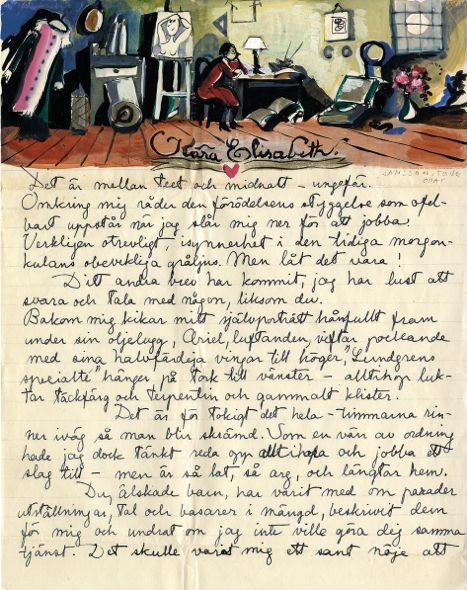
Early days: Tove Jansson went to Stockholm to study art when she was just 16. A letter to her friend Elisabeth Wolff, from November 1932
Artist and author Tove Jansson (1914–2001) is known abroad for her Moomin books for children and fiction for adults. A large selection of her letters – to family, friends and lovers – was published for the first time in September. In these extracts she writes to her best friend Eva Konikoff who moved to the US in 1941, to her lover, Atos Wirtanen, journalist and politician, and to her life companion of 45 years, artist Tuulikki Pietilä.
Brev från Tove Jansson (selected and commented by Boel Westin and Helen Svensson; Schildts & Söderströms, 2014; illustrations from the book) introduced by Pia Ingström
7.10.44. H:fors. [Helsinki]
exp. Tove Jansson. Ulrikaborgg. A Tornet. Helsingfors. Finland. Written in swedish.
to: Miss Eva Konikoff. Mr. Saletan. 70 Fifty Aveny. New York City. U.S.A.
Dearest Eva!
Now I can’t help writing to you again – the war [Finnish Continuation War, from 1941 to 19 September 1944] is over, and perhaps gradually it will be possible to send letters to America. Next year, maybe. But this letter will have to wait until then – even so, it will show that I was thinking of you. Curiously enough, Konikova, all these years you have been more alive for me than any of my other friends. I have talked to you, often. And your smiling Polyfoto has cheered me up and comforted me and has also taken part in the fortunate and wonderful things that have happened. I remembered your warmth, your vitality and your friendship and felt happy! At first I wrote frequently, every week – but after about a year most of it was returned to me. I wrote more after that, but the letters were often so gloomy that I didn’t feel like saving them. Now there are so absurdly many things I have to talk to you about that I don’t know where to begin. Koni, if only I’d had you here in my grand new studio and could have hugged you. After these recent years there is no human being I have longed for more than you. More…
The painter who wrote
6 October 2014 | Non-fiction, Reviews
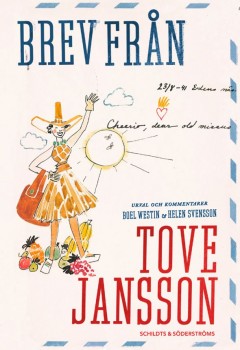 Brev från Tove Jansson
Brev från Tove Jansson
Urval och kommentarer Boel Westin & Helen Svensson
[Letters from Tove Jansson, selected and commented by Boel Westin & Helen Svensson]
Helsingfors: Schildts & Söderströms, 2014. 491 pp., ill.
ISBN 978-951-52-3408-7
€34.90
In Finnish (translated by Jaana Nikula):
Kirjeitä Tove Janssonilta
ISBN 978-951-52-3409-4
Nothing could be more mistaken than to describe Tove Jansson as ‘Moominmamma’. In her statements she was both cutting and complex – conflict-ridden and full of paradoxes. And she was nobody’s mamma.
Tove Jansson (1914–2001) became world famous (especially ‘big’ in Japan) with her Moomins – the characters of her illustrated books for children (1945–1970) – and her books for adults are a part of her work that is at least as interesting. Her training, ambition and artistic passion were, however, focused on painting.
Anyone who has read Boel Westin’s excellent biography – now available in English, Tove Jansson: Life, Art, Words – ‘knows’ all this, but to experience it through Jansson’s own letters, in an alternating process of reflection and recreation, brings the problems close to the reader in quite a different way: one that is shocking, but also deeply human. More…
Tellervo Krogerus: Sanottu. Tehty. Matti Kuusen elämä 1914–1998. [Said. Done. The life of Matti Kuusi, 1914–1998]
22 May 2014 | Mini reviews, Reviews
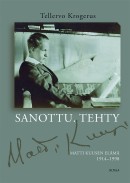 Sanottu. Tehty. Matti Kuusen elämä 1914–1998
Sanottu. Tehty. Matti Kuusen elämä 1914–1998
[Said. Done. The life of Matti Kuusi, 1914–1998]
Helsinki: Siltala , 2014. 856 pp., ill .
ISBN 978-952-234-194-5
€31.50, hardback
The folklorist Matti Kuusi vied for the status of the world’s leading researcher of proverbs with the Californian scholar Archer Taylor, his work extending from the shores of the Baltic Sea to Namibia’s Ovamboland. Proverbs revealed to him the deep structures of the human mind and showed that the nations of the world possessed a basis for mutual understanding. As a young man Kuusi read Spengler and predicted the destruction of the Western world. According to his ‘Kalevalan imperialism’, the Nordic region was to be the new world power. The war brought him to his senses: he understood that patriotism was mainly a matter of bland resilience. Professor Kuusi was a rigorous scholar, but also a provocative man of ideas who showed that pop music was today’s folk poetry. That idea received a mixed reception, but nowadays his department studies both rap music and ancient folk song. This biography by Tellervo Krogerus creates a rich portrait of a complex personality.
Translated by David McDuff
Updated, alive
8 May 2014 | Non-fiction, Reviews
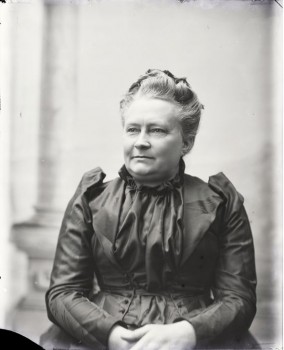
Minna at 50. The Finnish flag is flown on her birthday: 19 March has been named the Day of Equality. Canth also flies on the tail of one of the aircrafts of the Nordic airline Norwegian: the fleet carries portraits of ‘heroes’ and ‘heroines’ of four Nordic countries (the other Finn is the 19th-century poet J.L. Runeberg). Original photo: Viktor Barsokevich / Kuopio Museum of Cultural History
Herkkä, hellä, hehkuvainen – Minna Canth
[Sensitive, gentle, radiant – Minna Canth]
Helsinki: Otava, 2014. 429 pp., ill.
ISBN 978-951-1-23656-6
€40.20, hardback
There are two sure methods of preserving the freshness of the works of a classical author in a reading culture that is increasingly losing its vigour.
The first is to give a high profile to new interpretations of them, either in the form of scholarly lectures or of artistic re-workings, such as dramatisations, librettos or film scripts. Another unbeatable way to keep them alive as a subject of discussion is an updated biography, through which the author is seen with new eyes.
Minna Canth (1844–1897) is now celebrating her 170th anniversary, and she is fortunate in both respects. Having begun her literary career in the late nineteenth century, she still continues to be Finland’s most significant female writer.
Her influence on the role of women in society and, in particular, her promotion of girls’ education, is the cornerstone of Finland’s social equality. In the twenty-first century Canth’s plays are still receiving new interpretations, and they have also been made into operas and musicals. (Read her short story, ‘The nursemaid’, here.) More…
Juhani Suomi: Mannerheim – viimeinen kortti? Ylipäällikkö-presidentti [Finland plays its last card – Mannerheim, Commander-in-chief and President]
30 April 2014 | Mini reviews, Reviews
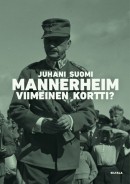 Mannerheim – viimeinen kortti? Ylipäällikkö-presidentti
Mannerheim – viimeinen kortti? Ylipäällikkö-presidentti
[Finland plays its last card – Mannerheim, Commander-in-chief and President]
Helsinki: Siltala, 2013. 836 pp., ill.
ISBN 978-952-234-172-3
€32, hardback
In his book Professor Juhani Suomi – well-known as the biographer of President Urho Kekkonen – focuses on the life and actions of Marshal Gustaf Mannerheim (1867–1951) during the final phase of the Continuation War between Finland and the Soviet Union beginning in1943 and, in particular, during his term as Finnish President from 1944 to 1946. Mannerheim was elected President by exceptional procedure, and his difficult task was to lead Finland from war to peace, which he succeeded in doing. Suomi seeks to reply specifically to the question of whether Mannerheim lived up to the myth that was created about him, and of whether he was Finland’s last chance as the guarantor of the country’s independence during those fateful years, as he is often presented. On the basis of a number of sources, the author draws a critical portrait of an aristocrat: this was a man who was cold and vain, who at every turn thought mainly of his own posthumous reputation and who as an elderly leader was slow and fickle in his decisions – though the reader will not necessarily agree with all of Suomi’s conclusions. Well-written, occasionally a bit too detailed, his book vividly describes a dramatic period in Finland’s recent history.
Translated by David McDuff
Remembrance
29 March 2014 | This 'n' that
 This year is the centenary of Tove Jansson (1914–2001), the painter, caricaturist, comic strip artist, illustrator and author of books for both children and adults, and, what made her name internationally, the creator of the Moomins. Today, her Moomin books are available in 40 languages.
This year is the centenary of Tove Jansson (1914–2001), the painter, caricaturist, comic strip artist, illustrator and author of books for both children and adults, and, what made her name internationally, the creator of the Moomins. Today, her Moomin books are available in 40 languages.
One sunny April day, walking through the atmospheric old Hietaniemi cemetery by the sea in Helsinki, a charming little bronze statue on top of a narrow granite column caught my eye.

Family grave: sculpture by Victor Jansson
It was a small child balancing on a ball, waving its arms and legs joyously in the air. On a closer look, there was something white attached to the statue: it was a tiny white plastic Moomin.
On the Janssons’ family grave the first little blue flowers had just risen to the surface to bask in the early spring sun. Tove’s father was the sculptor Victor Jansson, her mother was the cartoonist and artist Signe Hammarsten Jansson.
Perhaps one of Tove’s fans had chosen this way of paying homage to the creator of the unique Moomin universe.

Jorma Ollila – Harri Saukkomaa: Mahdoton menestys. Kasvun paikkana Nokia [Impossible success. Nokia as a growth point]
27 March 2014 | Mini reviews, Reviews
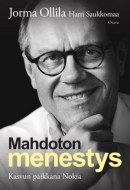 Mahdoton menestys. Kasvun paikkana Nokia
Mahdoton menestys. Kasvun paikkana Nokia
[Impossible success. Nokia as a growth point]
Helsinki: Otava Publishing Company , 2013. 480 pp., ill .
ISBN 978-951-1-18117-0
€39.60, hardback
One of the most fascinating stories in Finland’s recent history is the rapid rise of Nokia, thanks to the establishment of its mobile phones as a global brand in the 1990s, the decline in the company’s success in the 2000s, and its eventual abandonment of mobile phones. The boom was personified by the company’s talented CEO Jorma Ollila. His interesting memoirs are readily accessible to a non-specialist readership. When Ollila began work at the Nokia conglomerate in 1985 he had already shown an aptitude for business. He served first as the company’s director of finance, then as leader of the mobile phone unit, became managing director, and finally CEO from 1999 until 2006. Ollila decided to weed out the operations that were in difficulty and to focus on mobile phones and networks. With the support of a good management team, Ollila proved to be an energetic leader who knew how to share responsibility and also inspire and create trust. In his memoirs he analyses both the company’s successes and its mistakes and losses in the period up to 2010. Ollila stepped down from the post of chairman in 2012.
Translated by David McDuff
Tuomo Pietiläinen & Tutkiva työryhmä [Research working group]: Wahlroos: epävirallinen elämäkerta [Wahlroos: an unofficial biography]
13 February 2014 | Mini reviews, Reviews
 Wahlroos: epävirallinen elämäkerta
Wahlroos: epävirallinen elämäkerta
[Wahlroos: an unofficial biography]
Helsinki: Into Kustannus Oy, 2013. 432 pp. , ill.
ISBN 978-952-264-243-1
€35, hardback
Björn Wahlroos (born 1952) is a business and banking executive who is now chairman of Nordea, the Nordic region’s largest bank. The journalist Tuomo Pietiläinen, working in collaboration with 25 students, has produced a biography of Wahlroos as part of a course in investigative journalism, without the involvement of the subject himself. Wahlroos is a firm believer in the hard market economy. Based on careful background research, this biography charts Wahlroos’s progress from boy scout to radical left-wing student, his conversion to capitalism and his rapid rise to become a popular professor of economics. In the 1980s Wahlroos moved to the banking sector and climbed to the top of Finland’s business elite. Outspoken, both admired and hated, he is also the owner of an estate with cultural and historical significance, where he works as a part-time farmer. His hunting partners include the King of Sweden. This account of Wahlroos’s colourful career is written clearly and informatively enough to be understood even by those who don’t know anything about business.
Translated by David McDuff
Mikko-Olavi Seppälä & Riitta Seppälä: Aale Tynni. Hymyily, kyynel, laulu [Aale Tynni. A smile, a tear, a song]
16 January 2014 | Mini reviews, Reviews
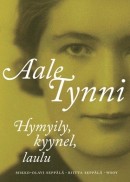 Aale Tynni. Hymyily, kyynel, laulu
Aale Tynni. Hymyily, kyynel, laulu
[Aale Tynni. A smile, a tear, a song]
Helsinki: WSOY, 2013. 488 pp., ill.
ISBN 978-951-0-38306-3
€37, hardback
The poet, author and translator Aale Tynni (1913–1997), an Ingrian Finn who came to Finland as a refugee after the First World War in 1919, published 15 collections of poetry between 1938 and 1987. Among her translations are works by Ibsen, Shakespeare, Yeats and Racine. This extensive biography, compiled and written by Tynni’s daughter Riitta Seppälä and her grandson, historian Mikko-Olavi Seppälä, is an in-depth, lively portrait of a poet who, in her time, was both admired and criticised for her choices of form and content. Tynni felt that classical metrical tradition was closest to her, and patriotism was one of her themes; however, in the postwar years the freedom of rhythm of Finnish modernism began to flourish, and politics also gained strength in the literary world. In 1948 Tynni won the gold medal for literature in the – rather bizarre and short-lived – art competitions at the Summer Olympics in London with her poem ‘Laurel of Hellas’. Tynni experienced dramatic turns in her personal life; she underwent a prolonged divorce from her first husband who bitterly fought it. Two of her three children committed suicide in adulthood. She was finally free to marry the widowed poet Martti Haavio (aka P. Mustapää) in 1960, a marriage of soulmates that lasted until Haavio’s death in 1973.


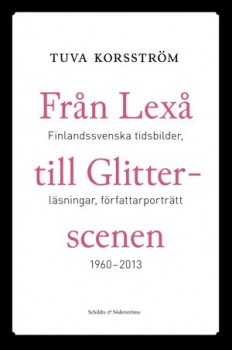 Tuva Korsström
Tuva Korsström